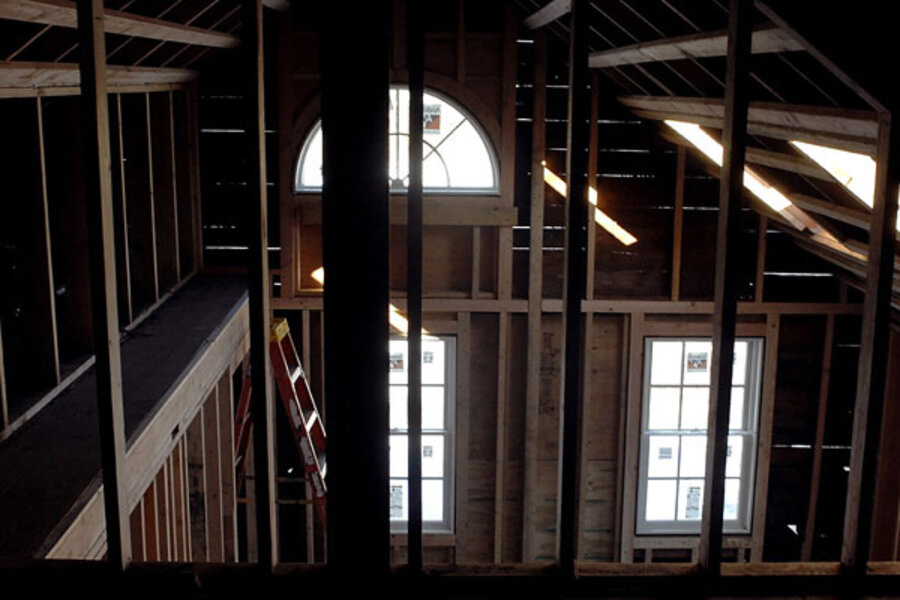For a more energy-efficient home, ample insulation is key
Loading...
The one thing that’s become clear as I stumble my way through the green renovation of Sheep Dog Hollow: Insulation is king.
Forget spending a fortune on solar power or geothermal if you’re thinking of greening up your current home. Every green expert I speak with always emphasizes the importance of dealing first and foremost with insulation in two forms: attacking air infiltration (sealing up all air leaks and drafts in a house) and increasing the amount of R-value (essentially the thickness of the blanket of insulation in the house.)
Doing so can save homeowners as much as 20 to 30 percent in their annual heating bills.
There are plenty of people who could benefit from a simple insulation upgrade. According to the site Simply Insulate, there are 46 million American homes that are “under-insulated.”
“If your home as little as 5 to 10 years old, you likely have one of the 46 million under-insulated homes in the US," according to the Harvard University School of Public Health. "Adding more insulation is easy. Plus, insulation is one of the lowest cost options for improving the energy efficiency of your home. It pays off fast and keeps paying off with better comfort and energy savings for as long as you own your home.”
At Sheep Dog Hollow, we opted to put in highly efficient spray foam insulation. It seals the house tight – think vacuum-packed house with foaming plastic. Once it’s done, we’ll be eligible for a federal tax credit of up to $1,500 as well as rebates from our local electric company for upgrading the insulation. (“Upgrade” is a generous term, though. When we bought Sheep Dog Hollow, the house had no insulation at all…)
But not every homeowner can do the kind of gut renovation we did – we stripped the house down to its bare studs so the spray foam, which is cutting edge in cutting down air infiltration, will be easy to install.
But most homeowners who an insulation upgrade have to work with what they have, and in the industry, that’s called a “retrofit.” So I called our local Anchor Insulation provider to find out what those homeowners can do.
“To incorporate spay foam in a retrofit, traditionally the roofline can be done, crawl spaces, or any kind of basement perimeters,” says Anchor’s Marek Ropiak. “Walls can also be done, but there can’t be any insulation in them at all.”
For houses that already have some insulation, but not enough, there are plenty of other options. The Energy Star website lists them, from increasing the amount of fiberglass batts to blowing in extra insulation through the walls.
Simply Insulate also has a handy tool that can help homeowners find the various state incentives that can help pay for an insulation upgrade. I was surprised when Mr. Ropiak mentioned that, at least here in Connecticut, sometimes the incentives and rebates can end up paying for the upgrades.
“There are phenomenal programs for existing homeowners through local electric providers,” he says. “A lot of these programs have been around for years. Now, with the cost of energy, they’re marketing it more significantly.”
The federal government, in a public-private partnership, also hopes to spur more homeowners to insulate with a proposed program that’s been called “Cash for Caulkers.” Its formal title is Home Star. The head of the coalition pushing it recently explained how it could work in a commentary on Forbes.com:
The exact structure of the Home Star program is still being worked out in Congress. The general idea is to provide near-term financial incentives that, in combination with private-sector investment, will stimulate a sharp increase in consumer demand for home energy improvements. The incentives were designed for rapid deployment in all 50 states, with rigorous standards and procedures in place to assure quality workmanship and prevent fraud.
I had heard there was an attempt to get the “Cash for Caulkers” program included in the current proposed jobs bill, but I still haven’t heard back from various sources as to whether that will happen or not.
I’ll let you know in the next blog what I can find out.
---
Follow us on Twitter and Facebook.
Alexandra Marks blogs twice a week about her green and budget-friendly restoration of a 1902 farmhouse in Connecticut. Click here to find all her blog posts and articles.





